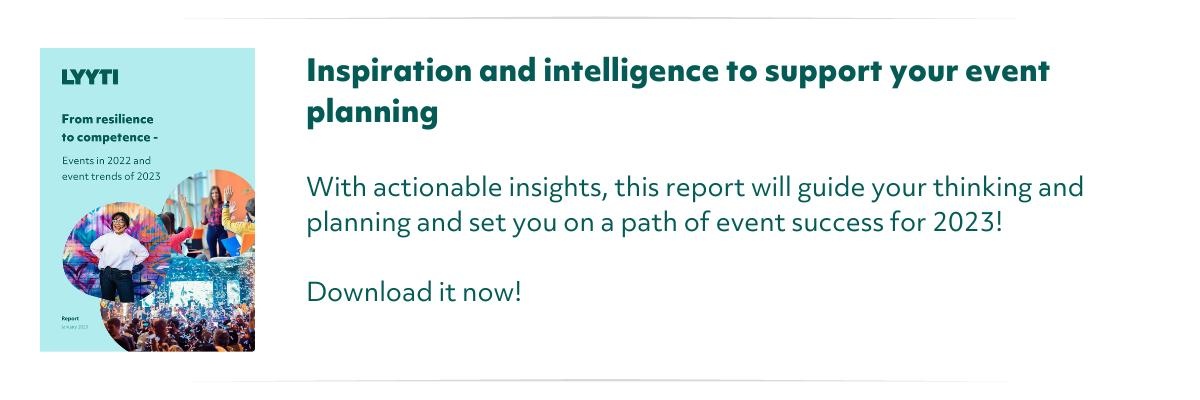Event Key Performance Indicators (KPIs) and analytics go hand-in-hand because you can’t have one without the other. You have to set goals for your events and whether you achieve the goals or not is determined by your KPIs.
Thankfully, we are not talking about a “which-comes-first-the-chicken-or-the-egg-situation.” KPIs always come first. You’ll have to decide a set of metrics that can determine if the goal you set for your event was achieved or not. These metrics (aka a data set) will be analysed and you get your event analytics. And the circle goes round and round. But more about this later on.
KPIs to consider for your events
There are several ways to measure B2B events, and the choice of metrics depends on your specific objectives and the nature of the event. You can make event specific goals or look at your events from a sales perspective and think about lead generation, for example.
You can have one main KPI or a combination of KPIs but they all have to be relevant in measuring if you achieved the goal you set for your event(s).
It's important to be as precise as possible in defining your KPIs to avoid ambiguity and ensure clarity in evaluating your event's performance.
By following the SMART rule for KPIs, you can set meaningful and effective goals for your event. Remember to be specific, measurable, achievable, relevant, and time-bound when defining your KPIs.
Here are some examples:
- Attendance and Participation Metrics
- Number of Attendees: The total number of participants who attended the event.
- Registrations: The number of individuals or companies that registered for the event.
- Participation Rate: The percentage of registered attendees who actually participated in the event.
- Engagement Metrics
- Session Attendance: Measure the number of attendees per session or workshop.
- Session Duration: The average time attendees spent in each session.
- Interactive Activities: Measure engagement with interactive elements like Q&A sessions, polls, and networking activities.
- Lead Generation and Networking Metrics
- New Leads: Count the number of new business leads or contacts generated from the event.
- Quality of Leads: Assess the relevance and potential of generated leads.
- Meetings Scheduled: The number of meetings or appointments scheduled during the event.
- Networking Interactions: Measure the number of interactions between attendees for networking purposes.
- Content Engagement
- Content Downloads: Track the number of downloads for event-related content such as presentations, white papers, and reports.
- Content Sharing: Measure how frequently event content is shared on social media or other platforms.
- Social Media Metrics
- Hashtag Performance: Monitor the usage and reach of event-related hashtags on social media platforms.
- Mentions and Impressions: Measure the number of times the event or its content is mentioned and seen on social media.
- Feedback and Satisfaction
- Surveys and Feedback: Collect feedback from attendees through surveys to assess their satisfaction, perceived value, and areas for improvement.
- Net Promoter Score (NPS): Measure the likelihood of attendees recommending the event to others.
- ROI and Revenue Metrics:
- Cost per Lead: Calculate the cost of generating each lead through the event.
- Revenue Generated: Track the actual revenue attributed to the event, such as sales closed as a result of leads generated.
- Return on Investment (ROI): Compare the total costs of the event to the revenue it generated to calculate ROI.
- Long-Term Impact
- Follow-up Engagement: Measure post-event engagement, such as continued interactions with leads or attendees.
- Long-Term Relationships: Track ongoing partnerships or collaborations that originated from the event.
- Qualitative Feedback
- Testimonials: Gather positive testimonials and quotes from attendees and partners.
- Anecdotal Evidence: Collect stories and anecdotes that showcase the event's impact on attendees and their businesses.
A case for participant-first KPIs
At Lyyti, we steadfastly believe that our events are only as successful as how the participants experience them.
This is why our main goal is to keep the Experience Value Score (EVS) as high as possible. Every event also has a few other KPIs that help us to measure how events contribute to our organisation's strategic goals.
But more about participant-first KPIs. At Lyyti, we see that each event is made only by its participants. If you don't have participants, you don't have an event either. All participants are also united by the fact that they are each individuals who experience and see the world very subjectively. No two experiences are ever the same at the same event. Only the participant himself can evaluate the participant's experience.
The participant's experience is affected by many things. Some of them are things that you, as the organiser of the event, can influence. But for the most part you don't. The personal experience is influenced above all by the participant's own expectations, life situation, the company the participant ends up with during the event and, for example, a good or bad customer service experience that has hit the spot. Each experience is unique.
There is one thing that unites all participants: in order to participate in your event, they have invested their time in it. Time is a non-renewable natural resource that we all have a limited but unpredictable amount of. Each of us makes small investment decisions every day. Do I go for a run in my free time or do I watch a movie with my family? How will I spend my next meeting-free hour? It's all about investing time, and therefore the participant experience should be measured relative to the time investment.
The measure we developed, the Experience Value Score (EVS), measures the value experienced by the participant immediately and subjectively. The participant simply answers one question: "Was the event worth your time?"
Align with the event portfolio
Your event goals and KPIs also need to align with your event portfolio. The event portfolio makes event activities measurable and manageable. Openly written goals and easy-to-follow metrics help the planning, implementation, evaluation and development of events.
When all of your events follow a strategy and commonly understood goals, it’s simple and straightforward for the whole organisation to grasp the purpose of your events.
Once you have determined your event strategy and created the event portfolio based on your strategy, the goals for each individual event will basically fit into place like pieces of a puzzle.
Your event KPIs should be a reflection of your organisation’s strategic goals and the purpose of an individual event.
Event analytics reveal misalignment
Event KPIs on their own can reveal certain details about your operations, but only when you ask this data set the right questions, will you understand if the actions meet the purpose.
Thinking about the relationship of KPIs and event analytics involves understanding how these two concepts are interconnected and how they contribute to the success of your events.
Here's a framework to help you think about this relationship:
- Defining Event KPIs
Start by identifying the KPIs that are critical to measuring the success of your event. These KPIs directly align with your event's goals and objectives. Scroll up for some KPI examples.
- Selecting Event Analytics
Event analytics involve collecting and analysing data related to your event's performance. This includes data from various sources such as ticketing systems, registration platforms, social media, surveys, website analytics, and more.
Choose the analytics tools and platforms that can effectively capture the data you need to measure your selected KPIs. This might involve using tools like Google Analytics, event management software, social media monitoring tools, etc.
- Data Collection
Ensure that the necessary data points are being collected throughout the event lifecycle. This data can include attendee registrations, ticket sales, website traffic, social media interactions, app usage, etc. The accuracy and completeness of the data collected will directly impact the accuracy of your event analytics.
To deepen your understanding, try to collect the same data over a longer period of time. For example, analysis of no-shows over many months and by event type, can reveal when you should organise events and what type of events are most visited.
- Data Analysis and Insights
Analyse the collected data to gain insights into the performance of your event. This involves looking for patterns, trends, correlations, and anomalies in the data.
For example, you might analyse attendance patterns, peak engagement times, conversion rates at different stages of the event, and more. These insights help you understand what's working well and what areas need improvement.
- Comparing to KPIs
Compare the insights derived from your event analytics to the predefined KPIs. This step allows you to assess whether you're meeting your goals and objectives.
For instance, if your KPI is to achieve a certain number of participants and your analytics show a lower turnout, you can identify this misalignment and take corrective actions.
- Iterative Improvement
Run an event retro and use the insights gained from your event analytics to inform future event planning and strategy.
If you achieved your KPIs, analyse what strategies contributed to that success. If you fell short, identify areas for improvement and adjust your approach for future events.
- Feedback Loop
The relationship between event KPIs and analytics is cyclical. As you gather data, analyse it, and adjust your strategies, you're constantly refining your approach. The feedback loop helps you fine-tune your event planning and execution over time, leading to more successful events.
You can read more about this process we call the Event Success Management.
Remember that the relationship between event KPIs and event analytics are symbiotic. Clear and measurable KPIs guide your data collection efforts, while comprehensive event analytics provide the insights needed to optimise your event strategies and achieve your goals.
Hero photo by Getty











